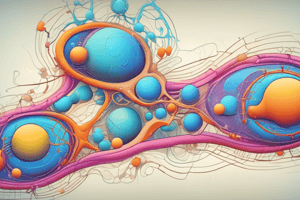Podcast
Questions and Answers
Where does glycolysis take place in the cell?
Where does glycolysis take place in the cell?
- cytosol (correct)
- nucleus
- mitochondrial matrix
- endoplasmic reticulum
What is the byproduct of the Krebs cycle that is used to generate ATP?
What is the byproduct of the Krebs cycle that is used to generate ATP?
- Glucose and ATP
- Acetyl-CoA and pyruvate
- NADH and FADH2 (correct)
- CO2 and ATP
What is the direct consumer of oxygen in aerobic respiration?
What is the direct consumer of oxygen in aerobic respiration?
- Electron transport chain
- Oxidative phosphorylation (correct)
- Glycolysis
- Krebs cycle
What is the product of glycolysis that is converted to acetyl-CoA?
What is the product of glycolysis that is converted to acetyl-CoA?
How many ATP and NADH are generated during glycolysis?
How many ATP and NADH are generated during glycolysis?
What is the primary purpose of glycolysis in aerobic respiration?
What is the primary purpose of glycolysis in aerobic respiration?
What is the role of acetyl-CoA in the Krebs cycle?
What is the role of acetyl-CoA in the Krebs cycle?
What is the final component of aerobic respiration?
What is the final component of aerobic respiration?
What is the common product of glycolysis and the Krebs cycle?
What is the common product of glycolysis and the Krebs cycle?
What is the purpose of NADH and FADH2 in cellular respiration?
What is the purpose of NADH and FADH2 in cellular respiration?
Flashcards
Location of glycolysis
Location of glycolysis
Glycolysis takes place in the cytosol of the cell.
Krebs cycle byproduct for ATP
Krebs cycle byproduct for ATP
NADH and FADH2 are byproducts of the Krebs cycle used to generate ATP.
Aerobic respiration's oxygen consumer
Aerobic respiration's oxygen consumer
Oxidative phosphorylation directly consumes oxygen.
Glycolysis to acetyl-CoA
Glycolysis to acetyl-CoA
Signup and view all the flashcards
Glycolysis ATP and NADH output
Glycolysis ATP and NADH output
Signup and view all the flashcards
Glycolysis's main purpose
Glycolysis's main purpose
Signup and view all the flashcards
Acetyl-CoA in the Krebs cycle
Acetyl-CoA in the Krebs cycle
Signup and view all the flashcards
Final aerobic respiration stage
Final aerobic respiration stage
Signup and view all the flashcards
Common product of glycolysis and Krebs cycle
Common product of glycolysis and Krebs cycle
Signup and view all the flashcards
NADH and FADH2's role
NADH and FADH2's role
Signup and view all the flashcards
Study Notes
Aerobic Respiration Components
- Aerobic respiration consists of three components: glycolysis, the Krebs cycle, and oxidative phosphorylation.
Glycolysis
- Glycolysis generates energy in the form of ATP from sugars.
- Occurs in the cytosol and splits glucose into two pyruvate molecules.
- Produces 2 ATP and 2 NADH as byproducts.
Krebs Cycle
- Pyruvate is converted to acetyl-CoA and enters the Krebs cycle in the mitochondrial matrix.
- Produces ATP, NADH, and FADH2 from acetyl-CoA.
Oxidative Phosphorylation
- Oxygen is directly consumed to generate ATP as the final component of aerobic respiration.
- NADH and FADH2 drive the electron transport chain to produce more ATP.
Aerobic Respiration Components
- Three components of aerobic respiration: glycolysis, the Krebs cycle, and oxidative phosphorylation.
Glycolysis
- Occurs in the cytosol.
- Breaks down glucose into two pyruvate molecules.
- Generates 2 ATP and 2 NADH.
The Krebs Cycle
- Occurs in the mitochondrial matrix.
- Converts pyruvate into acetyl-CoA.
- Produces ATP, NADH, and FADH2 from acetyl-CoA.
Functions of Krebs Cycle Products
- NADH and FADH2 drive the electron transport chain.
- Electron transport chain produces more ATP.
Oxidative Phosphorylation
- Only directly consumes O2 to generate ATP.
- Final component of aerobic respiration.
Studying That Suits You
Use AI to generate personalized quizzes and flashcards to suit your learning preferences.





